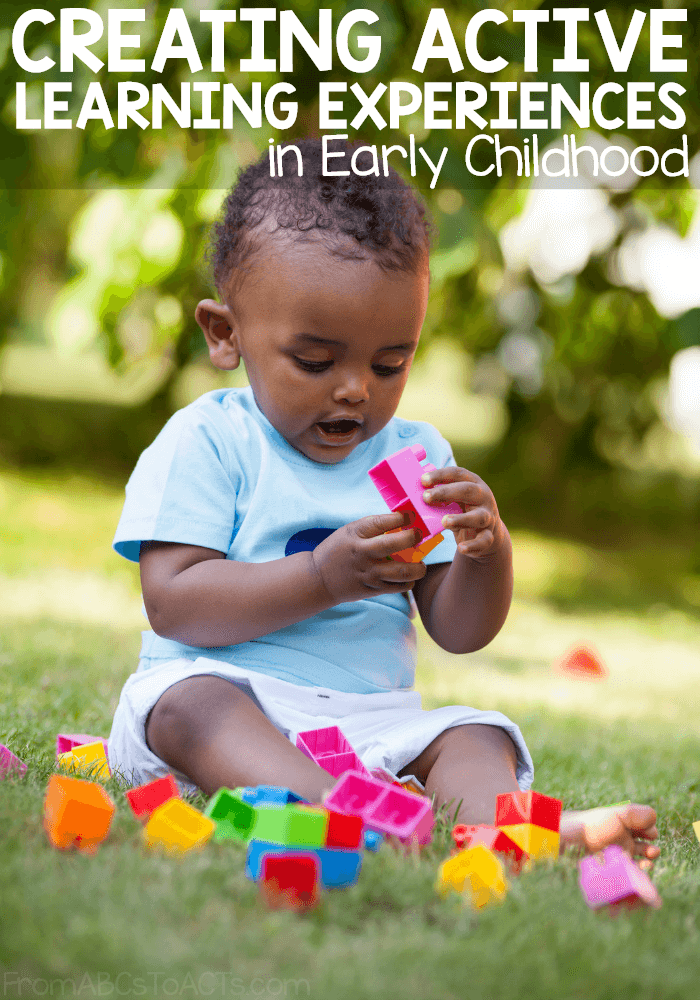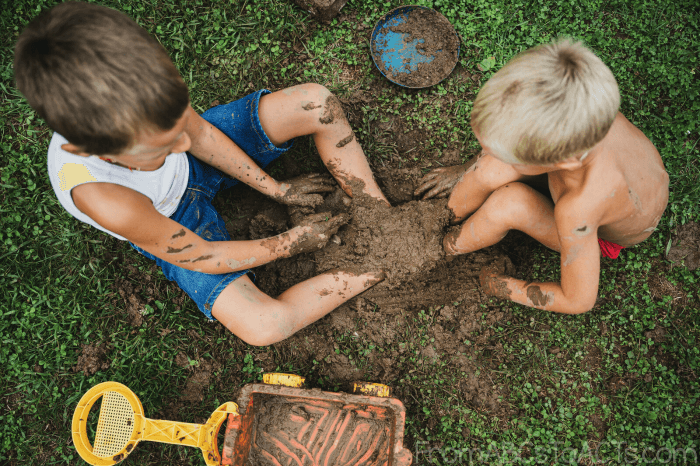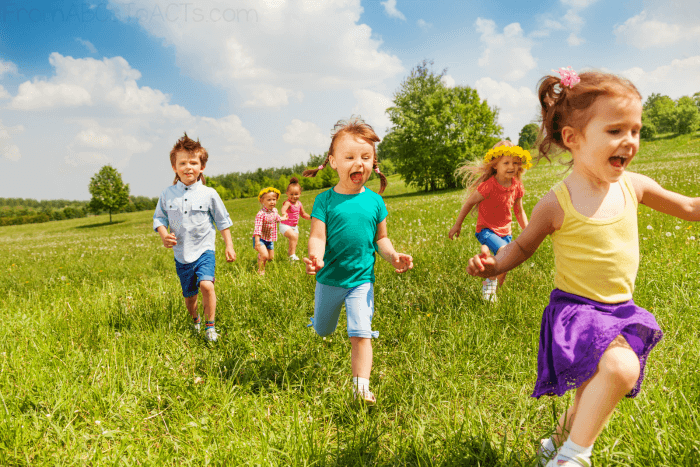This is a sponsored post. The sponsoring company compensated me for my time, however all opinions and text are my own. For more information, please see my full disclosure policy.
On this site, we talk a lot about learning through play.
In fact, one of the core beliefs behind From ABCs to ACTs and my own philosophy as an educator is the idea that children learn best through play, creativity, and exploration.
Especially when working with younger children in an early childhood setting, things like worksheets and memorization simply have no place.
Instead, children need to touch, manipulate, explore, and engage the world around them with all of their senses to truly learn and grow.
Fortunately, this belief is becoming more and more common among parents and teachers and can result in wonderful learning environments for young children that are rich in hands-on, active learning, but there are still some that struggle with knowing exactly how to implement this belief into their own classroom with their own students.
If you find yourself in that camp or know another teacher that does, have no fear!
Today, we’ve got some amazing (and easy!) ideas to share with you that will not only give you the opportunity to introduce more play into your classroom, but that will have your students more active and engaged as well!
This is a sponsored post on behalf of ChildCare Education Institute. I am being compensated for my time, however, all text and opinions are my own.
Every single one of these ideas are tried and true favorites! They’re also just a sample of the information included in CUR124: Active Learning Experiences in Early Childhood, which is the most recent course that I’ve taken through ChildCare Education Institute, one of my go-to resources for ECE professional development!

Creating Active Learning Experiences in Early Childhood
The ideas that we’re sharing with you today are simply meant to give you a starting point.
It’s important to remember that every classroom, every child, is different and you will need to tailor these ideas to fit the needs of your students.
Bring On the Sensory Play
If you want to see a massive amount of learning take place in a short amount of time, open up a sensory bin.
Sensory play is a fantastic way to create active learning experiences because it is engaging a child on so many different levels.
They’re using multiple senses to explore the new sights, smells, and textures.
They’re working on their motor skills as they scoop, pour, and dig.
They’re practicing their math skills and expanding their vocabularies as they explore the contents of the bin.
And if you want to expand it further, take the sensory play idea outdoors!
You won’t even need a bin!

Nature, in and of itself, is the most incredible sensory play experience.
Let them use their large motor muscles to run and climb. Let them dig in the sand, splash in the puddles, and even play in the mud!
They’ll learn more from an afternoon outside than they would from a month of worksheets.
Create Open-Ended Learning Opportunities
I am a firm believer that children learn far more from an experience when they are given the opportunity to explore it for themselves.
Rather than simply try to explain what happens in the vet’s office, for example, set up a veterinarian’s office in the dramatic play center and let them explore it on their own.
Encourage them to use their imagination and come up with their own pretend play.
One day, they may wind up working on their gross motor skills while flying around the playground pretending to be airplanes in their dramatic play airport, and the next, they may be honing their social skills as they work together as a group to run a pretend grocery store.
With preschoolers especially, you’d be surprised at what they can come up with when you give them a few ideas and then step back and let them take control.
Add More Games to Your Learning
No, I’m not talking about board games, although at times, those can be appropriate for older children.
Instead, I’m talking about simple games that engage the child’s whole body.

Games like tag, Duck, Duck, Goose, or even a bean bag toss can be a fantastic way to work on things like patience, taking turns, and being a good sport while providing an excellent active learning experience.
Giving your students the reigns and allowing them to make up their own games provides them with the perfect opportunity to practice working as a team as well.
Continue Your Own Learning
There are a thousand more ways to promote active learning experiences in the early childhood classroom and just as many reasons to do so.
Not only will your students be more engaged, but they’ll actually retain more of what you’re trying to teach them as well.
And while creating a more active, hands-on learning environment is fairly easy, it can be overwhelming if you’re not sure where or how to begin.
Fortunately, with ChildCare Education Institute, you don’t have to figure it out entirely on your own.
The points above can give you some ideas, of course, but to truly understand why children need these types of experiences so badly and how you, as an educator, can incorporate them into your classroom, I highly recommend CUR124: Active Learning Experiences in Early Childhood from CCEI.
This course presents practical methods for integrating movement, active involvement, and group games across all curriculum areas while also helping you to understand just why they are so important for your kids.
I’ve personally taken a number of courses through CCEI in addition to this one and every time I am blown away by just how in depth their courses are.
They continuously provide high-quality online training courses and programs that are applicable to those who work in an array of child care settings, including center-based care, Head Start, family child care, prekindergarten classrooms, after school environments and more.
They have more than 150 English and Spanish training courses that are available to meet licensing, recognition program, and Head Start requirements.
They also have online certification programs that provide the coursework requirement for national credentials including the CDA, Director and Early Childhood Credentials.
CCEI is a Council for Professional Recognition CDA Gold Standard℠ training provider, is accredited by the Distance Education Accrediting Commission (DEAC) and is accredited as an Authorized Provider by the International Association for Continuing Education and Training (IACET) so you know that every course you take is both beneficial and worth your time.
Make the Most of Your Own Educational Time
- With CCEI, you can earn CEU credits from the comfort of your couch 24/7/365
- CCEI courses are all web-based and are accessible anytime on any device
- 99 percent of students say they would recommend CCEI to others
- Nearly 6,000,000 online course hours completed by CCEI students
- CCEI has graduated over 18,000 early childhood professionals from CDA and other certificate programs
- 30 hours of new content added each year
- New users are eligible for a free trial course that changes each month
- IACET CEUs can be earned at no additional cost
When you have a high-quality institution like CCEI packaging all of the information up for you and adding so much value that you feel like an expert by the time you finish the course and earn your certificate of completion, it’s kind of a no brainer.

To learn more about CUR124: Active Learning Experiences in Early Childhood and the multitude of other fantastic courses offered by CCEI, click here to check out their course catalog.
By the end of this course alone, should you decide to give it a try, you’ll have a full understanding of why children need active learning experiences like these and you’ll walk away with a complete treasure trove of ideas that you can implement in your classroom immediately.